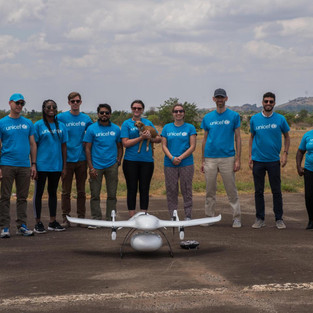Over the years, drones have become popular in the commercial and personal space. However, innovators are increasingly deploying customized drones to weather tough environments for a variety of emergency missions. On top of that, they are also fielding drones for round-the-clock monitoring to augment active and preventative measures. In this article, we will examine several of these real-life drone scenarios and the technology behind them to further the understanding of the invaluableness of drone technology to society.
Disaster Response & Relief
Devastating wildfires are a major occurrence in hotspots such as in California and the Australian bush. Unfortunately, fighting wildfires cost the lives of too many emergency personnel. While the most-at-risks are the firefighters on the ground, the airspace of a wildfire itself is hazardous not only because of embers, smoke, and pyrocumulonimbus storms but the high volume of low flying rescue and emergency aircrafts further exacerbates an already dangerous environment.
Therefore, firefighting departments are amongst the most supportive of drone solutions to reduce the risks involved for their personnel. While most drones are too small and hence carry too little water to put out fires on their own, they are nonetheless very useful in providing situational awareness for firefighters in targeting hotspots. In an emergency, effective and efficient direction of resources is paramount. When equipped with IR cameras, drones can also identify people in need of rescue especially in dense smoke and limited visibility.
In a typical wildfire, the terrain becomes hazardous as a raging inferno can quickly spread, blocking access to roads and pathways. Understandably, improving the situational awareness of ground teams especially over walls of fire or the forest canopy is imperative. To that end, firefighters of New South Wales, Australia have used drones since 2016 as part of a broader push of improving data access for emergency management. Even after the fire subsides, drones are also very useful during recovery efforts. In Victoria, conservationists used drones to identify and rescue koala bears threatened by fires. Furthermore, drone seeding can help in regeneration projects to maintain the ecosystem. In the future, forest services are also expected to use AI-enhanced drones to monitor wilderness trails for signs of impending bushfires.
Other than the valuable drone data, they can also actively conduct missions typically done by manned helicopters due to volatile weather and the expendability of drones. Drone Amplified’s IGNIS drone, attached to DJI’s M600 Matrice, is designed to conduct controlled burns by reducing the amount of flammable vegetation so that a potential wildfire will be more easily contained. IGNIS systems are equipped with 400 ‘dragon eggs’, ball-shaped containers filled with potassium permanganate. Flying above the dropzone, IGNIS automatically punctures the eggs with glycol that will start a chemical reaction and ignite 30 to 60 seconds after dropping.
This concept and the ignition spheres themselves have been used for decades by manned helicopters. However, attaching it to a drone platform offers a far more improved solution. Flying closer to the ground and working in tandem with accurate GPS data, the drone can automatically drop its payload along a pre-programmed flight path. As such, they can also return and rearm at the operator’s station hence finishing the controlled burn faster. The Department of Agriculture estimated that in 2020 alone, hundreds of thousands of ‘dragon eggs’ were dropped in firefighting efforts.
Health and Medicine
Drones already have a proven track record in data gathering with their onboard cameras. As a cost-effective flying platform, it can revolutionize the healthcare industry in many developing nations, particularly those with much deficiencies in infrastructure. Indeed, with the ongoing pandemic and the development of vaccines, many nations are reevaluating their supply chains to inoculate their populations against COVID-19.
In rural Malawi, the United Nations International Children’s Emergency Fund (UNICEF) carried out successful pilot programs to expedite HIV testing for babies. Doctors and medical technicians take an average of 6 to 8 hours to travel to these remote villages due to poor vehicle and road access. Not only will testing be faster, some of the drones they trialed were able to carry up to 10kg worth of medicine and antimalarials. In addition, UNICEF also experimented with using drones as a data hub. With almost non-existent telecommunications networks, doctors in the field cannot easily share data. Instead, a drone with the stored data will fly over the targeted area and allow recipients on the ground to download from it via Bluetooth or Wi-Fi. Needless to say, these initiatives show a great potential for drones to improve access to healthcare for millions worldwide.
Meanwhile in Sweden, the national emergency firm, SOS Alarm with partnerships, are developing paramedical drones that can transport automated external defibrillators (AEDs) to people suffering heart attacks. In doing so, bystanders will now have more life-saving measures at their disposal while awaiting for the ambulance to arrive. In the future, they are planning to accommodate more people and more types of emergency medical requirements.
Besides this, advances in remote sensing and artificial intelligence (AI) is now allowing drones to operate in the most hazardous of environments. RISER (Remote Intelligence Survey Equipment for Radiation), developed in the United Kingdom, is equipped with sophisticated equipment that can identify radioactive hotspots while also flying inside industrial facilities without a Global Positioning System (GPS) signal. High radioactivity interferes with radio frequencies, RISER instead uses an internal collision avoidance system designed for beyond visual line of sight (BVLOS) operations in complex, cluttered environments. In 2016, it was fielded at Sellafield’s decommissioned nuclear reprocessing plant. Two years later, it was used to inspect damaged reactors of Japan’s Fukushima Daiichi nuclear power plant.
Law Enforcement
While armed drones have captured the public’s imagination, there are many other ways drones can be useful to law enforcement authorities without strapping weapons on them. As already stated, drone data is invaluable in helping enhance situational awareness for boots on the ground. For the police, a high-level view can be decisive during tense encounters including chasing suspects, hostage situations and other acute crises.
However, drones can also greatly reduce manpower needs for investigative work. There is much evidence at crime or accident scenes hence it requires delicate handling yet plenty of hands involved in securing the area and collecting them. Photogrammetry allows creation of highly detailed 3D orthomosaics of a scene with drone data. Investigators would then have a clearer view of the entire area. This is particularly useful as they can go back to the recreated scene that is more accurate at the time of reporting than after the fact when evidence can be lost due to natural and unnatural means. At night, drones can also be equipped with bright spotlights that illuminate the scene for forensic teams in more meticulous analysis.
Ironically, the prevalence of drones is also spurring growth in anti-drone devices. These can come in many forms from signal jammers to lasers. However, for the police, snatching rogue drones with minimal damage is a greater priority to catch misbehaving operators. France’s Malou Tech developed a relatively low-tech solution by simply equipping a larger drone with a net to capture smaller drones. This electronic hawk would then allow investigators access to the physical device and the evidence on it.
Besides this, the safety of mass gatherings can be further improved with drone surveillance. Advanced algorithms allow identification of bad actors even when they are moving through crowds, this will allow officers to neutralize the threats before anything happens. In the opposite, drones armed with megaphones can better help to coordinate the masses and prevent panic especially when disaster strikes. In high-risk bomb threat scenarios, dedicated bomb disposal robots are far too bulky to deploy at a moment’s notice. Instead, flying an expendable drone to assess the situation is very useful to operational planning for special response teams or to quickly root out false alarms and misdirection.
Drones are far less risky and very cost-effective to field. Expanding drone technology to more emergency services can be vital to saving lives and better serving citizens. To that end, the flourishing drone industry is ready to meet the needs of the public.
If you are thinking about drones and want to know how to start, contact us today.
Drone Academy Asia
admin@droneacademy-asia.com





















































Comments